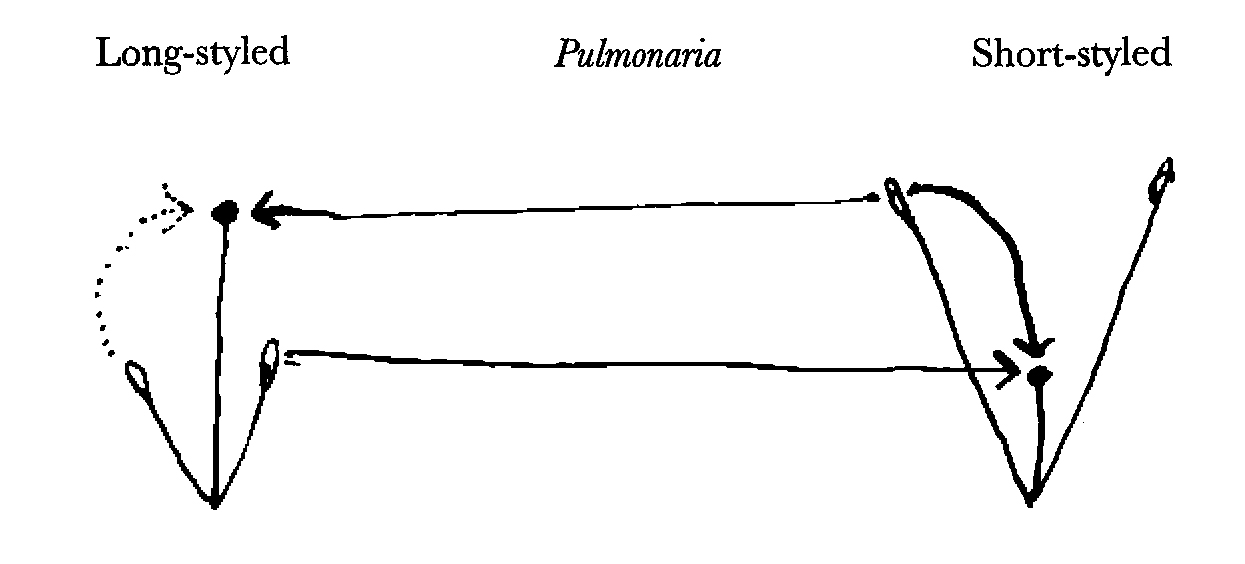To W. E. Darwin 14 May [1864]1
Down. | Bromley. | Kent. S.E.
May 14
My dear William
You have really done the work splendidly I shall say in my paper that you first observed the fact & I shall give all the description on your authority.2 By aid of an old letter you have counted I think you have counted above 200 plants.3 I have looked again & I can see length of anthers is extremely variable.4 Theoretically the anthers of long-styled ought to be shortest & so I have generally found them5 If you have any flowers in bud & can spare time, open them & compare the indehissent anthers of the 2 forms, for this is of some real importance. It seemed to me that the anthers of long styled with smaller pollen-grains contain many more shrivelled & worthless grains: this theoretically ought to be so but I compared only 2 anthers6 the enclosed diagram will explain what I can pretty plainly see will be the result of my crosses.7 The case is quite new & will explain I believe a whole class of cases like that of common thyme.8
yrs. C.D.
(Your slavey’s keep will cost about 22£ a year but that is no reason against her if she will be useful on the whole).
Aunt Eliz. is coming today.9
yours dear W.
P.S. Frank10 told me that some rarish Echium grew on shore near S—ampton. When in flower I shd much like to hear about its flowers, whether dimorphic like Pulmonaria, or like our Echium, with anthers quite aborted in one form.—11
I shd like to see its flowers
[Enclosure]12

The 3 black unbroken lines show perfect fertility
The 1 dotted line shows complete sterility.
The anthers of long-styled are, I believe, tending to abortion.13
The ancestor of Echium vulgare I believe was once in exact state of Pulmonaria, the anthers of long-styled having since quite aborted—14
Footnotes
Bibliography
Collected papers: The collected papers of Charles Darwin. Edited by Paul H. Barrett. 2 vols. Chicago and London: University of Chicago Press. 1977.
Correspondence: The correspondence of Charles Darwin. Edited by Frederick Burkhardt et al. 29 vols to date. Cambridge: Cambridge University Press. 1985–.
‘Dimorphic condition in Primula’: On the two forms, or dimorphic condition, in the species of Primula, and on their remarkable sexual relations. By Charles Darwin. [Read 21 November 1861.] Journal of the Proceedings of the Linnean Society (Botany) 6 (1862): 77–96. [Collected papers 2: 45–63.]
Forms of flowers: The different forms of flowers on plants of the same species. By Charles Darwin. London: John Murray. 1877.
‘Three forms of Lythrum salicaria’: On the sexual relations of the three forms of Lythrum salicaria. By Charles Darwin. [Read 16 June 1864.] Journal of the Linnean Society (Botany) 8 (1865): 169–96. [Collected papers 2: 106–31.]
Summary
Discusses WED’s observations on polymorphic flowers.
Letter details
- Letter no.
- DCP-LETT-4495
- From
- Charles Robert Darwin
- To
- William Erasmus Darwin
- Sent from
- Down
- Source of text
- DAR 97: A1–2, A4–5
- Physical description
- L(S)(A) 5pp inc sketch
Please cite as
Darwin Correspondence Project, “Letter no. 4495,” accessed on 19 April 2024, https://www.darwinproject.ac.uk/letter/?docId=letters/DCP-LETT-4495.xml
Also published in The Correspondence of Charles Darwin, vol. 12


